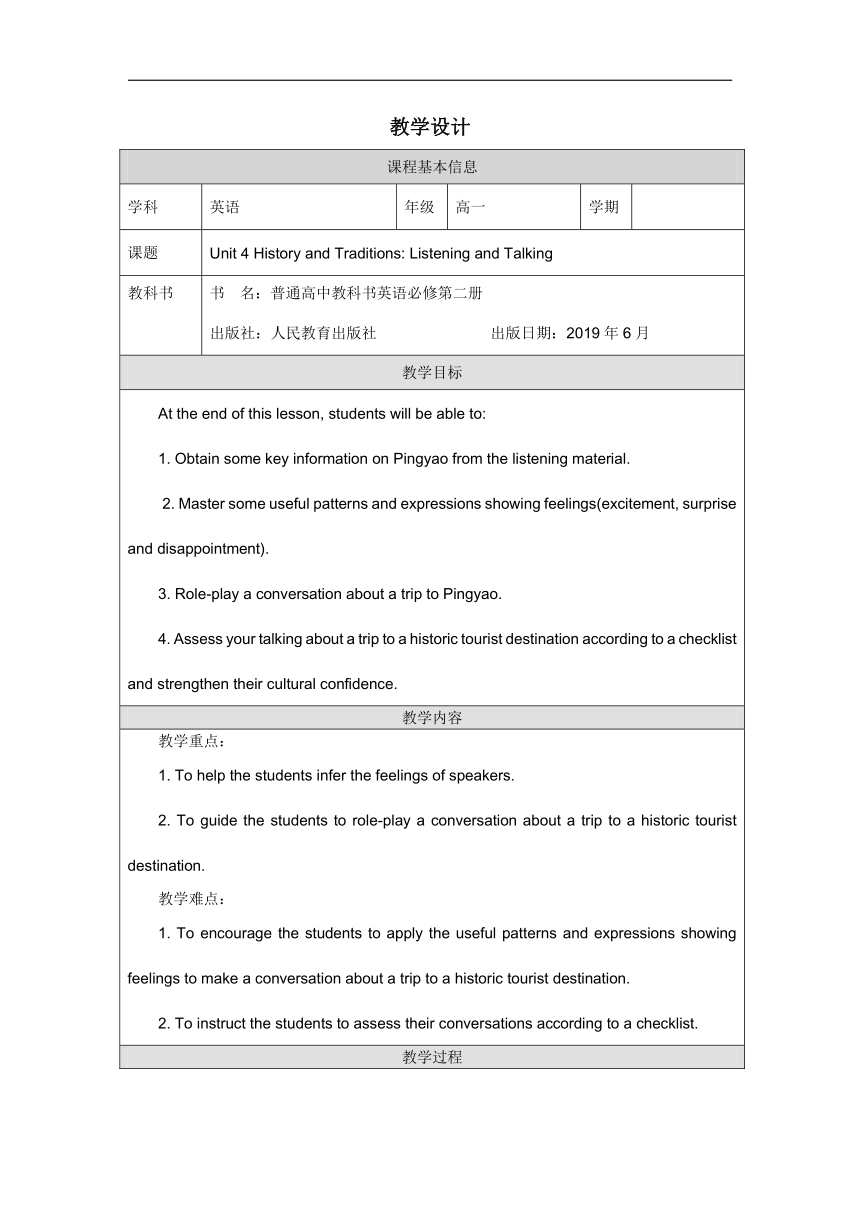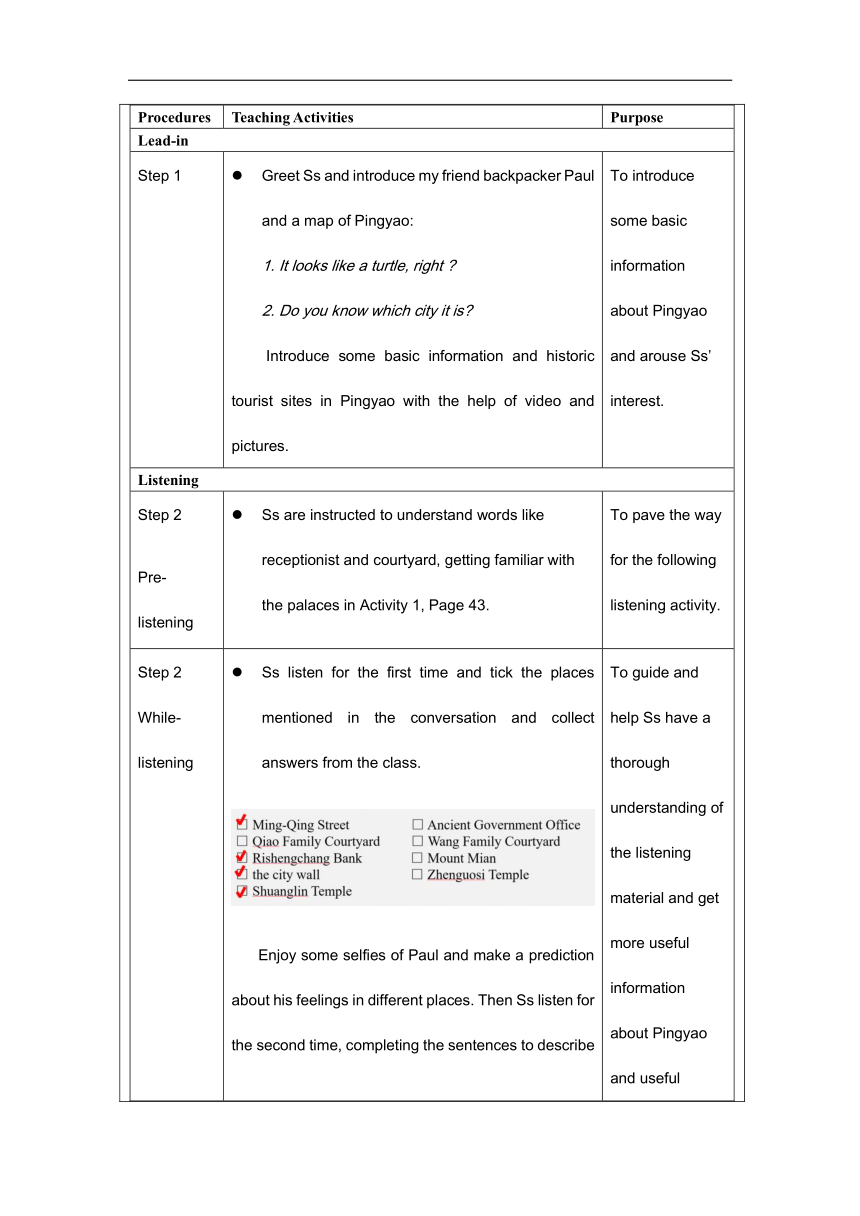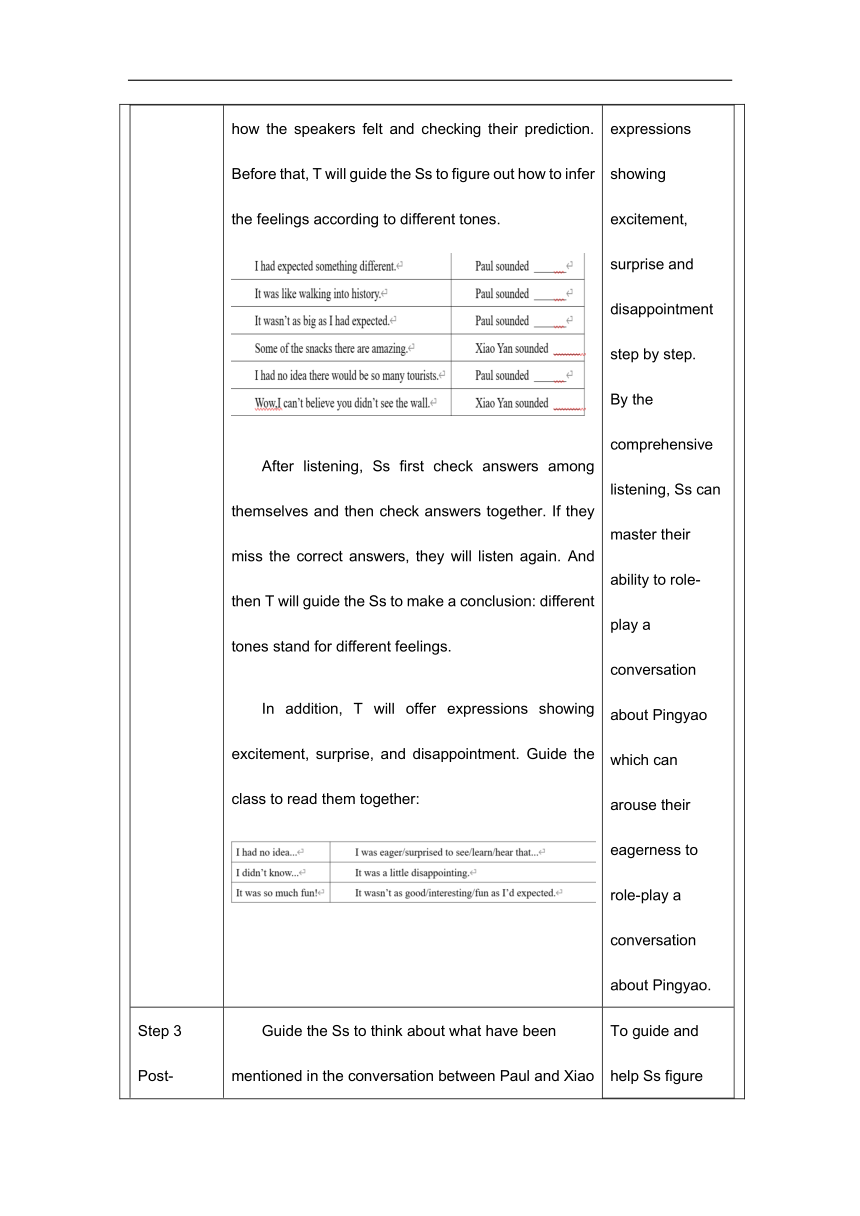人教版(2019) 必修 第二册Unit 4 History and traditions Listening and Talking教学设计(表格式)
文档属性
| 名称 | 人教版(2019) 必修 第二册Unit 4 History and traditions Listening and Talking教学设计(表格式) |

|
|
| 格式 | docx | ||
| 文件大小 | 386.4KB | ||
| 资源类型 | 教案 | ||
| 版本资源 | 人教版(2019) | ||
| 科目 | 英语 | ||
| 更新时间 | 2024-05-17 20:09:25 | ||
图片预览



文档简介
教学设计
课程基本信息
学科 英语 年级 高一 学期
课题 Unit 4 History and Traditions: Listening and Talking
教科书 书 名:普通高中教科书英语必修第二册 出版社:人民教育出版社 出版日期:2019年6月
教学目标
At the end of this lesson, students will be able to: 1. Obtain some key information on Pingyao from the listening material. 2. Master some useful patterns and expressions showing feelings(excitement, surprise and disappointment). 3. Role-play a conversation about a trip to Pingyao. 4. Assess your talking about a trip to a historic tourist destination according to a checklist and strengthen their cultural confidence.
教学内容
教学重点: 1. To help the students infer the feelings of speakers. 2. To guide the students to role-play a conversation about a trip to a historic tourist destination. 教学难点: 1. To encourage the students to apply the useful patterns and expressions showing feelings to make a conversation about a trip to a historic tourist destination. 2. To instruct the students to assess their conversations according to a checklist.
教学过程
ProceduresTeaching ActivitiesPurposeLead-in Step 1 Greet Ss and introduce my friend backpacker Paul and a map of Pingyao: It looks like a turtle, right Do you know which city it is Introduce some basic information and historic tourist sites in Pingyao with the help of video and pictures.To introduce some basic information about Pingyao and arouse Ss’ interest.ListeningStep 2 Pre-listeningSs are instructed to understand words like receptionist and courtyard, getting familiar with the palaces in Activity 1, Page 43.To pave the way for the following listening activity.Step 2 While-listening Ss listen for the first time and tick the places mentioned in the conversation and collect answers from the class. Enjoy some selfies of Paul and make a prediction about his feelings in different places. Then Ss listen for the second time, completing the sentences to describe how the speakers felt and checking their prediction. Before that, T will guide the Ss to figure out how to infer the feelings according to different tones. After listening, Ss first check answers among themselves and then check answers together. If they miss the correct answers, they will listen again. And then T will guide the Ss to make a conclusion: different tones stand for different feelings. In addition, T will offer expressions showing excitement, surprise, and disappointment. Guide the class to read them together: To guide and help Ss have a thorough understanding of the listening material and get more useful information about Pingyao and useful expressions showing excitement, surprise and disappointment step by step. By the comprehensive listening, Ss can master their ability to role-play a conversation about Pingyao which can arouse their eagerness to role-play a conversation about Pingyao. Step 3 Post-listeningGuide the Ss to think about what have been mentioned in the conversation between Paul and Xiao Yan with the help of a mind map: T draw a conclusion that when we talk about our traveling experience of a historic tourist destination, we can talk about its local food, famous streets, buildings, culture, statues. Additionally, arts, history can also be included.To guide and help Ss figure out the content of a conversation about a trip to a historic tourist destination, which will help them to fulfill their content of the conversation.Talking and evaluateStep 4 Role-play and assessSs are asked to role play the conversation about an imaginary trip to Pingyao and continue the conversation in Activity 3 on Page 43 Play the recording of the conversation sample about Pingyao. Besides T will give 2 tips to Ss for their reference to take turns talking about other historic tourist destinations of Activity 4 on Page 43: Tip 1: Pick a place and list the historic sites, such as ancient street, statues, local food, traditions. such as Beijing’s Forbidden City, Terracotta Army, The Mogao Caves and so on. Tip 2: Use the sentences that we just learned to help you express excitement, surprise and disappointment. Offer a checklist for the Ss to do Self-assessment & Peer assessment by answering the yes/no questions: A possible version of the conversation in the form of video is provided to encourage Ss to make the conversation. A: How is your trip to Xi’an B: Wow, it’s fantastic. At first, I went to Terracotta Army, where I was amazed at so many well-preserved statues. A: That sounds attractive. So how about the food there B: To be honest, the food there was (not) as tasty as I had expected, and/but the Chinese hamburger is a good choice. A: Yeah, I know what you mean. Which tourist attraction do you like best B: Datang everbright city of course. You couldn’t imagine how amazed and proud it is to learn about the culture of Tang dynasty. A: It seems that you really enjoyed your trip. I’m eager to have a trip to Beijing. I can’t wait for my vacation.To develop Ss’ ability of talking about a historic tourist destination using useful expressions showing different feelings, which can strengthen their self-confidence and help them have a better understanding of our traditional culture. Assessment: To improve Ss’ assessment ability and help them enhance what they have learned through this lesson, which can also provide a platform for Ss to share and learn mutually.AssessmentStep 5Ss are asked to assess their progress according to the table:Step 6Ending: T concludes this lesson and tell the students that: Love our culture and rejuvenate the nation.To guide Ss to realize the importance of our traditional culture and also raise Ss’ cultural confidence. 课时作业设计Homework: complete the conversation and write a passage for the presentation (within 150 words), which includes: the historic tourist destination the traveling experience including places of interest, food, traditions, etc. the feelings of your visit The Intention of this homework: Help students have a better understanding of our traditional culture. Encourage students to express their feelings using proper expression. Improve students’ English writing ability.
课程基本信息
学科 英语 年级 高一 学期
课题 Unit 4 History and Traditions: Listening and Talking
教科书 书 名:普通高中教科书英语必修第二册 出版社:人民教育出版社 出版日期:2019年6月
教学目标
At the end of this lesson, students will be able to: 1. Obtain some key information on Pingyao from the listening material. 2. Master some useful patterns and expressions showing feelings(excitement, surprise and disappointment). 3. Role-play a conversation about a trip to Pingyao. 4. Assess your talking about a trip to a historic tourist destination according to a checklist and strengthen their cultural confidence.
教学内容
教学重点: 1. To help the students infer the feelings of speakers. 2. To guide the students to role-play a conversation about a trip to a historic tourist destination. 教学难点: 1. To encourage the students to apply the useful patterns and expressions showing feelings to make a conversation about a trip to a historic tourist destination. 2. To instruct the students to assess their conversations according to a checklist.
教学过程
ProceduresTeaching ActivitiesPurposeLead-in Step 1 Greet Ss and introduce my friend backpacker Paul and a map of Pingyao: It looks like a turtle, right Do you know which city it is Introduce some basic information and historic tourist sites in Pingyao with the help of video and pictures.To introduce some basic information about Pingyao and arouse Ss’ interest.ListeningStep 2 Pre-listeningSs are instructed to understand words like receptionist and courtyard, getting familiar with the palaces in Activity 1, Page 43.To pave the way for the following listening activity.Step 2 While-listening Ss listen for the first time and tick the places mentioned in the conversation and collect answers from the class. Enjoy some selfies of Paul and make a prediction about his feelings in different places. Then Ss listen for the second time, completing the sentences to describe how the speakers felt and checking their prediction. Before that, T will guide the Ss to figure out how to infer the feelings according to different tones. After listening, Ss first check answers among themselves and then check answers together. If they miss the correct answers, they will listen again. And then T will guide the Ss to make a conclusion: different tones stand for different feelings. In addition, T will offer expressions showing excitement, surprise, and disappointment. Guide the class to read them together: To guide and help Ss have a thorough understanding of the listening material and get more useful information about Pingyao and useful expressions showing excitement, surprise and disappointment step by step. By the comprehensive listening, Ss can master their ability to role-play a conversation about Pingyao which can arouse their eagerness to role-play a conversation about Pingyao. Step 3 Post-listeningGuide the Ss to think about what have been mentioned in the conversation between Paul and Xiao Yan with the help of a mind map: T draw a conclusion that when we talk about our traveling experience of a historic tourist destination, we can talk about its local food, famous streets, buildings, culture, statues. Additionally, arts, history can also be included.To guide and help Ss figure out the content of a conversation about a trip to a historic tourist destination, which will help them to fulfill their content of the conversation.Talking and evaluateStep 4 Role-play and assessSs are asked to role play the conversation about an imaginary trip to Pingyao and continue the conversation in Activity 3 on Page 43 Play the recording of the conversation sample about Pingyao. Besides T will give 2 tips to Ss for their reference to take turns talking about other historic tourist destinations of Activity 4 on Page 43: Tip 1: Pick a place and list the historic sites, such as ancient street, statues, local food, traditions. such as Beijing’s Forbidden City, Terracotta Army, The Mogao Caves and so on. Tip 2: Use the sentences that we just learned to help you express excitement, surprise and disappointment. Offer a checklist for the Ss to do Self-assessment & Peer assessment by answering the yes/no questions: A possible version of the conversation in the form of video is provided to encourage Ss to make the conversation. A: How is your trip to Xi’an B: Wow, it’s fantastic. At first, I went to Terracotta Army, where I was amazed at so many well-preserved statues. A: That sounds attractive. So how about the food there B: To be honest, the food there was (not) as tasty as I had expected, and/but the Chinese hamburger is a good choice. A: Yeah, I know what you mean. Which tourist attraction do you like best B: Datang everbright city of course. You couldn’t imagine how amazed and proud it is to learn about the culture of Tang dynasty. A: It seems that you really enjoyed your trip. I’m eager to have a trip to Beijing. I can’t wait for my vacation.To develop Ss’ ability of talking about a historic tourist destination using useful expressions showing different feelings, which can strengthen their self-confidence and help them have a better understanding of our traditional culture. Assessment: To improve Ss’ assessment ability and help them enhance what they have learned through this lesson, which can also provide a platform for Ss to share and learn mutually.AssessmentStep 5Ss are asked to assess their progress according to the table:Step 6Ending: T concludes this lesson and tell the students that: Love our culture and rejuvenate the nation.To guide Ss to realize the importance of our traditional culture and also raise Ss’ cultural confidence. 课时作业设计Homework: complete the conversation and write a passage for the presentation (within 150 words), which includes: the historic tourist destination the traveling experience including places of interest, food, traditions, etc. the feelings of your visit The Intention of this homework: Help students have a better understanding of our traditional culture. Encourage students to express their feelings using proper expression. Improve students’ English writing ability.
